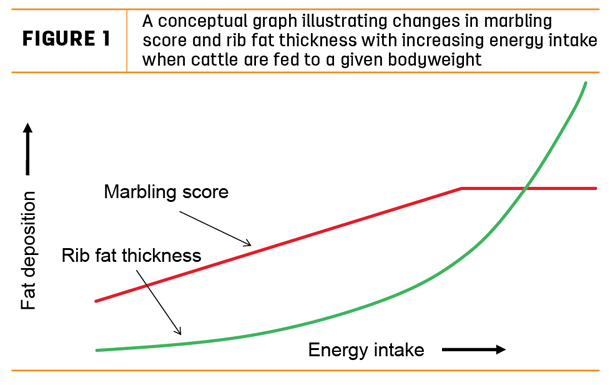Premiums are paid for cattle with USDA quality grade of upper two-thirds Choice or greater, and cattle are sometimes over-fattened in an attempt to achieve higher quality grades.
However, over-fat cattle having USDA yield grade 4 and 5 typically receive a discount in a grid-based pricing system that offsets the premium received for higher quality grades. Additionally, excess fat deposition in less desirable locations in the carcass, such as rib fat and internal fat, are an inefficient use of feed.
Thus, achieving high marbling score without excess rib fat will improve income from grid-based pricing systems and reduce feed costs.
Genetic potential for fat deposition affects the percentage of cattle with USDA yield grade 4 or 5. British breed cattle, which have a high propensity to deposit fat both as marbling and rib fat, are more likely to result in yield grade 4 or 5 when fed high-energy diets for a long period of time.
Continental and Zebu breeds of cattle have a lower propensity to deposit fat and have less issues with excess rib fat when fed a high-energy diet and, in fact, typically require longer periods on a high-energy diet to achieve acceptable carcass fat. As British breed cattle, particularly Angus, are a large percentage of the cattle population, the following discussion focuses on research results utilizing British breeds of cattle.
The past theory on marbling development
Marbling and rib fat are very different in their development, but it has been difficult to develop nutritional management strategies to increase marbling relative to rib fat. In the past, it was thought that to achieve their genetic potential for marbling, cattle needed to be fed high-grain, high-energy diets during the backgrounding and finishing phases.
Several studies have investigated the amount of energy intake and level of grain in the diet during the backgrounding phase on marbling and rib fat in the carcass.
Cattle placed on high-grain diets fed ad libitum throughout the backgrounding and finishing phases (i.e., calf-fed cattle) have greater rib fat thickness than cattle that were fed a low- to moderate-energy backgrounding diet prior to finishing on a high-grain diet (i.e., yearling-fed cattle).
But the cattle fed a high-grain diet ad libitum throughout backgrounding and finishing have similar marbling score as those fed a low- to moderate-energy backgrounding diet. Thus, high-energy backgrounding diets increase rib fat thickness in the carcass but not marbling score.
Additionally, the level of grain in the backgrounding diet does not change marbling or rib fat in the carcass when cattle are fed a high-grain diet during finishing.
Comparison of cattle limit-fed a high-grain diet during backgrounding to achieve similar rate of gain as cattle fed a high-forage diet ad libitum indicates that both groups of cattle have similar marbling and rib fat in the carcass following finishing on a high-grain diet. Thus, energy source in the backgrounding diet when fed at similar energy intake does not affect marbling or rib fat in the carcass.
A new theory on marbling development
High-energy backgrounding diets can increase rib fat deposition 60 to 80 percent, but marbling score increases only 20 to 40 percent at the end of the backgrounding phase. These percentages indicate that marbling fat deposition is limited in some manner.
Recent research indicates that marbling fat cell development is associated with bodyweight of cattle such that at a given bodyweight there is a set number of marbling fat cells that can be filled with fat.
This means that the number of marbling fat cells are constant at a given bodyweight regardless of the rate of gain to reach that bodyweight. The energy intake and rate of gain to reach that bodyweight affects the amount of fat in those cells, but not the number of marbling fat cells.
Once those marbling fat cells are filled, additional energy from the diet is stored as rib fat. Thus, feeding a high-energy backgrounding diet to lightweight feeder cattle quickly fills the available marbling fat cells, resulting in the additional energy being stored as rib fat as discussed with calf-fed cattle above.
Figure 1 illustrates the change in marbling score and rib fat thickness when cattle are fed increasing energy intake to achieve a given bodyweight.

When fed a low-energy diet, cattle will be lean, having a low marbling score and rib fat thickness when reaching a given bodyweight.
Conversely, when fed a high-energy diet, cattle will have a high marbling score and a very high rib fat thickness when reaching a given bodyweight.
However, as depicted by the flat part of the line for marbling score, there is a level of energy intake where the available marbling fat cells have been filled with fat, and any additional energy from the diet is deposited as rib fat. This level of energy intake would result in optimum yield and quality grade, but it is currently unknown and will require further research.
The optimum energy intake may vary with the target slaughter weight, the genetic potential for marbling versus rib fat deposition and, likely, other factors.
To summarize, cattle can be backgrounded and finished to their genetic marbling potential on less than maximum energy intake. Moderating energy density of the diet and energy intake during the backgrounding phase can be a strategy to moderate rib fat thickness and yield grade in British breed cattle while still maximizing the genetic potential of the cattle for marbling. ![]()
PHOTO: New research shows the number of marbling fat cells are constant at a given bodyweight, regardless of rate of gain. Photo by Staff.

-
Phillip Lancaster
- Assistant Professor - Beef Cattle Production
- Darr School of Agriculture
- Missouri State University
- Email Phillip Lancaster








